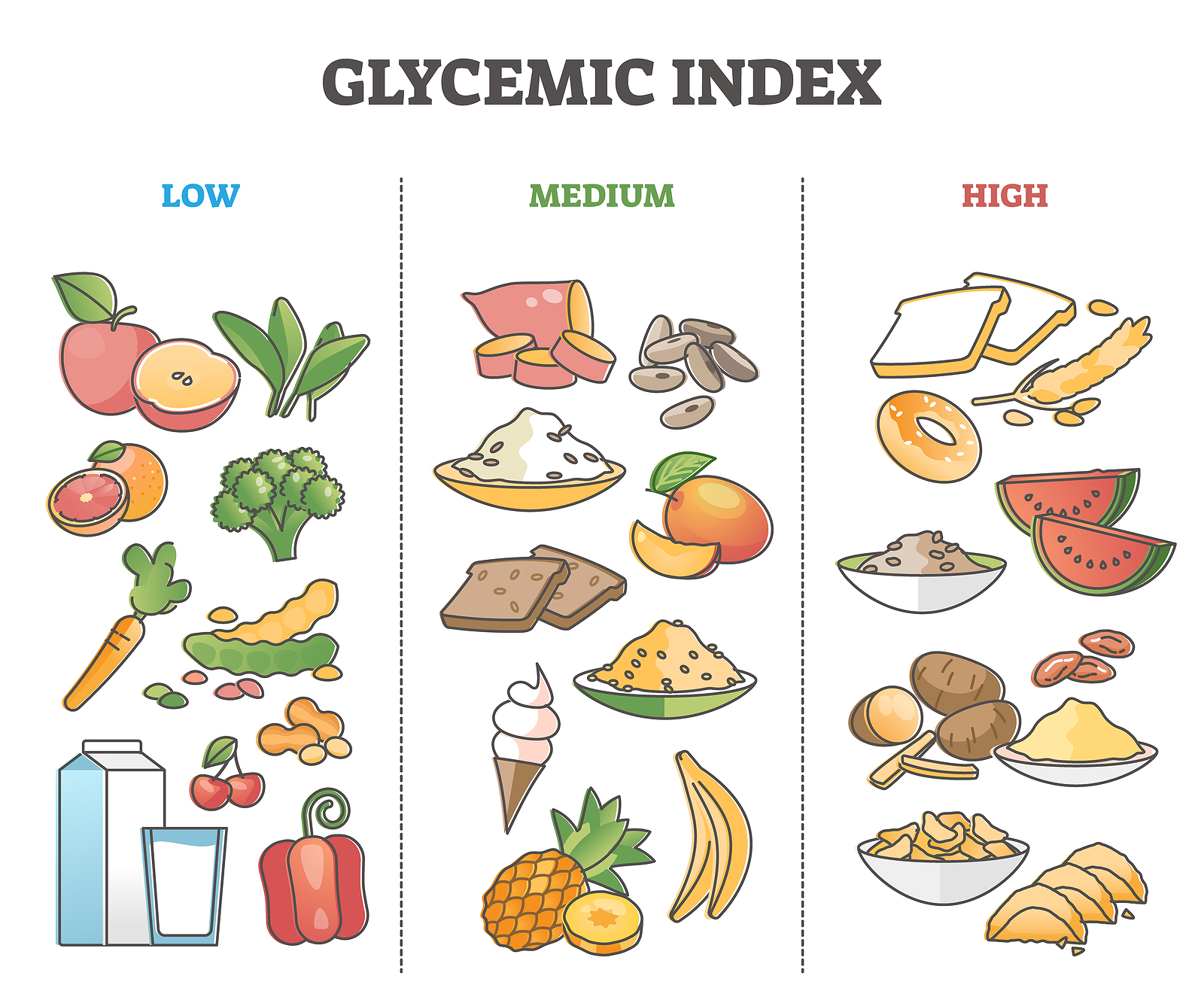The glycemic index (GI) is a tool used to promote better blood sugar management. This is done by giving a value to specific foods for how much they will increase blood sugar levels. Many things can affect a food’s GI including nutritional composition, cooking method, ripeness and amount of processing it has gone through. Knowing what foods are in the different categories of the GI can help people who want to lose weight or someone trying to manage their blood sugar and cholesterol. It is important to note that glycemic index (GI) is different from glycemic load (GL). GI does not take into consideration the amount of food eaten whereas GL takes the carbs in a serving of food to determine how it will affect your blood sugar. Both GI and GL are important to consider when choosing foods that will promote healthy blood sugar levels.
The three categories of GI are:
- Low (55 or less)
- Examples – apple, barley and soybeans
- Medium (56 to 69)
- Examples – ripe banana, corn and multigrain bread
- High (70 or above)
- Examples – watermelon, potato and white bread
When the GI in a food is lower, it will not affect your blood sugar as much as it would if it was high. Foods with high GI levels are the ones that can be digested quickly like sugars and refined carbs. Low GI foods take longer to digest, like high in protein, fat and fiber. It is surprising for most people that watermelon has such a high GI but it is because of all the natural sugar it contains. The reason soybeans have such a low GI is because they are high in fat and protein making them slower to digest.
Not only can the macronutrients of food affect the GI value but also how the food is prepared will change value. Fried foods often tend to be lower in GI value because the fat it is fried in will slow down digestion whereas if you roast or bake a food it will break down starch in the food that slows down digestion causing digestion of that certain food to actually speed up. This will increase the GI value of the food. Boiling foods is one of the best ways to cook when trying to eat low GI foods because it doesn’t add any additional fat when cooking but also maintains and sometimes even lowers the GI value due to retaining the resistant starch. When cooking foods like rice and pasta, it is best to not overcook them because the longer they cook the more easily digestible they become. The stage of ripeness can also affect GI values, especially in fruits like bananas.
GLYCEMIC INDEX DIET
The glycemic index diet is a plan that follows the index as the primary guide for creating meal plans. This diet is unlike others because it doesn’t specify portion sizes or count calories, it’s just based on how the food affects your blood sugar. A low GI diet is targeted to people with obesity related diseases like type 2 diabetes and cardiovascular disease. For most people with diabetes, counting carbohydrates and understanding the glycemic index can lead them to being able to control their blood glucose levels better. On the other hand, a low GI diet has also been criticized for not being very reliable.
An advantage to following a low glycemic index diet is it can help manage your blood sugar levels, which is especially important if you have diabetes. Maintaining proper blood sugar levels can help delay the onset or even prevent complications like heart disease, stroke, and damage to the kidneys or liver. Studies show that the long term effects of following a low GI diet can reduce hemoglobin A1C levels which is a marker for blood sugar control. Low GI diets have also been proven to lower cholesterol, reduce risk for cancer and help you succeed in long term weight loss.
Following a low GI diet also has its drawbacks. The glycemic index doesn’t give a full nutritional picture because it doesn’t take fat, protein, sugar and fiber into consideration. An example of this is french fries are 75 on the GI but a baked potato is 93. This is due to how the potato was prepared and could lead someone who is trying to pick the lower GI food, to pick the one with more fat. The GI value given to a particular food is not based on a serving size so while the GI of watermelon is around 75, but since watermelon has very few digestible carbohydrates you would have to eat a lot of watermelon to actually raise your blood sugar that much. This is why understanding GL, that does take serving size into consideration, is very important when following a low GI diet.
Oppositely, following a high GI diet is linked to a greater risk of developing type 2 diabetes. Eating high GI foods can spike your blood sugar quickly, putting stress on your body. Foods high on the glycemic index are typically full of sugar and overly processed. Lowering the GI of foods you eat is the best way to relieve some of this stress on your body. On the plus side, there are low GI versions of our favorite high GI foods, like bread and rice, that can make keeping that weight off a little easier.
Not all foods high on the glycemic index are “bad”, they just aren’t the best choice for you if you are prediabetic, diabetic or predispositioned for other diseases. That being said, not all foods low on the glycemic index are good for you either. Some are extremely high in fat so while they may not raise your blood sugar, they will still make you gain weight. While following a low glycemic index diet has some great benefits like reducing blood sugar and losing weight, it should be used in tandem with other diets that include tracking calories, fat, fiber and vitamins. Following a high GI diet is almost never a good idea, even if you are not currently overweight. This will ensure you are getting a healthy, balanced diet while also being proactive about reducing your blood sugar. If you are interested in learning more about reducing your blood sugar levels, please contact us.

